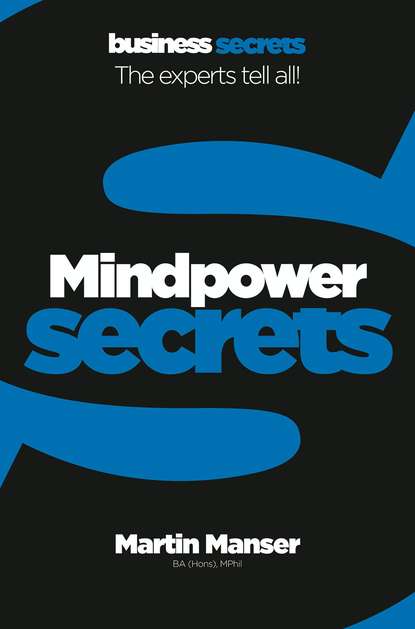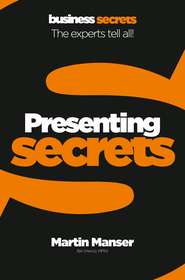По всем вопросам обращайтесь на: info@litportal.ru
(©) 2003-2024.
✖
Mindpower
Автор
Год написания книги
2019
Настройки чтения
Размер шрифта
Высота строк
Поля
3 Prepare. If you are giving a presentation, there is no substitute for working hard on research to make sure you have all the relevant facts. Perhaps you don’t know where to start? A mind map may help you (see Secret 1.6).
4 Analyse the facts. Think them through and examine them from different angles. Challenge assumptions and distinguish between facts and opinions. Explore weaknesses and find gaps in an argument. Think through the reasons why something has developed as it has. Uncover the background causes of an event. Analyse all data critically.
5 Put the facts together (synthesize them). Evaluate different options. Think of new ways of putting things together. For example, you may think of developing better systems at work: a combination of logic and creativity will help you do this.
Give yourself space to be imaginative and come up with exciting new ideas.
1.6 Draw a pattern diagram (#ulink_265b5ed7-9a53-5d3e-b911-4e083bab3da5)
A pattern diagram is a creative drawing that captures what you judge to be the main aspects of a central thought that you want to consider.
Many people find drawing a pattern diagram (also called a mind map, pattern notes or a spider diagram) helpful to see all the parts of a subject and how they fit together. It can be useful for taking notes, brainstorming a topic or researching a subject. Here’s how to prepare a pattern diagram in seven steps:
1 Take a blank sheet of A4 paper and place it on the table in a landscape format.
2 Write with a pencil your central subject (a word or a few words, not a whole sentence) in the middle of the paper.
case study In order to plan a course on Report Writing, I used a pattern diagram to write down all I knew about the audience: their needs, what they already knew and the level of proficiency I wanted them to achieve. I broke down the major points that I wanted them to learn into manageable chunks. During the seminar, it really helped to have a clear summary that I could refer to on one sheet of paper.
3 Write around that central word other key words that relate to it; let your imagination move you. Think of subdivisions of that subject, or facts that relate to the subject.
4 Keep branching out various other aspects of the subject that come into your mind. These other aspects can cover a variety of points, such as facts relating to the subject, your feelings about a subject, and the advantages or disadvantages of following different courses of action. If you get stuck at any point, stimulate your thinking by answering the question words: ‘who?’, ‘where?’, ‘when?’, ‘what?’, ‘how?’ and ‘why?’
5 At this stage, do not reject any thoughts. (Use an eraser only sparingly to delete what you have written.)
6 You could colour in different key words to show which ones are related. You could also use symbols, images or pictures if you find that helpful.
7 You could also number the different key words to give them a hierarchy of importance.
Let your imagination stimulate you, and you will be able to draw a pattern diagram that captures the different aspects of a subject.
1.7 Change your thinking (#ulink_d28e20fd-6c90-5dae-9b99-a7470def286f)
It’s all too easy to think in the same way that we are used to – for our thoughts, feelings and habits to get stuck in a rut. This need not last, however: you can learn to think differently!
Ways to help you think differently:
• Try a new approach. Move on from the “we’ve-always-done-it-this-way” approach and rethink things, both logically and creatively.
• Think positively. If you tend to always raise objections about how and why something won’t work, stop yourself and try to view a situation constructively instead. If you combine your natural caution with a new optimism, you may be able to improve the plans.
• Reconsider yourself and your career. Look at your work situation from a fresh perspective. Is there room for improvement?
case study The British designer and engineer James Dyson challenged accepted ways of thinking when, in the 1980s, he launched the first bagless vacuum cleaner. He had been frustrated by the way that conventional cleaners lose power as the bags fill up with dust and dirt. Delivering more power to the vacuum cleaner may have been one (partial) solution, but instead, Dyson adopted a different way of thinking. He started from the premise that vacuum cleaners were no longer ‘allowed’ to have bags, and this led him to devise an entirely different approach – the cyclone system – which has proved remarkably successful.
• Think creatively. Change from narrow to original thinking. If you have trouble developing innovative, creative ideas, try using a device such as the pattern diagram (Secret 1.6) to help fire your imagination.
• Change your habits. It can help to learn new skills in order to give you a broader set of tools for tackling work and solving problems.
All of these ways of thinking differently involve taking risks. If you are naturally cautious, you may be unwilling to take risks. Think why this is. Here are some possible reasons:
• “I don’t want to make a fool of myself.” The response to this is simply, “does this really matter?”
• “It might not work out.” The response to this is to quote the saying, “a person who never made mistakes never made anything”.
• “It’ll take a long time.” Well yes, it may, but think how you learnt to drive or how you learnt a foreign language. Weren’t these incredibly worthwhile skills that took some time to learn?
Just because you have done things in a certain way in the past doesn’t mean you have to follow that way always. You can change your way of working.
1.8 Develop as a whole person (#ulink_3faa177c-16f2-5922-8cfb-27a9da7218bb)
We are not just people who think. We are humans – sentient, emotional, physical beings. And as part of developing mind power, you need to develop yourself as a whole human being.
Here is a list to prompt and encourage your development.
• Break your normal routine. You can start in an easy fashion simply by watching different programmes on television; seek out a more diverse range of programmes than you usually watch.
• Read about current affairs. Devour your favourite website, a quality newspaper or periodical such as The Economist or Newsweek.
• Think. Don’t just read. Think about the big underlying issues to problems, news stories and other narratives. Take time to reflect. Schedule in time to relax your mind from concentrated action.
• Challenge yourself. Move out of your comfort zone. For example, I recently was a student for a four-week intensive course – I found the experience demanding as it was 35 years since I was last a student on an educational course!
• Jot and sketch. Carry a pencil and notebook, or electronic equivalent, with you to jot down or sketch fresh ideas as they come to you.
one minute wonder Rather than working through your lunch break, go out and look around you. Break your routine: buy sandwiches from a different shop, go to a different café or order different food. Look around you with a fresh pair of eyes, take in the sights, smells and sounds. Imagine you’ve just landed in your city as a tourist – what would you notice?
• Learn to listen. But don’t just listen…really listen. What are people saying and not saying? Reflect on what you’re learning. Talk with friends and colleagues. Discuss issues and ideas; express your latest thinking to gauge responses.
• Be alert to your different senses. Make yourself look up at the sky. Stop for a moment or two and listen to the sounds around you. Reflect on them. They are part of who you are. (Drinking Coca Cola reminds me of a family holiday in France, for example.)
• Absorb some culture. Go to an art gallery or museum. Or, if that doesn’t take your fancy, go to a trade exhibition.
• Care for others. Don’t become so absorbed with yourself that you neglect people around you, in your community and in the wider world. Engage in some practical action to be helpful.
• Get physical. Take up a physical sport such as jogging, cycling or swimming. As well as the health benefits, it will help relax your mind.
• Express your artistic side. If you are creatively inclined, fit that into your regular schedule.
• Meditate. Spend time in a form of prayer or meditation to help you connect with more than the physical world.
We are whole people and need to develop different aspects of our lives.
Read and listen more effectively (#ulink_fa1d4bbe-0fd7-58e7-9a1b-9800a8ad9a52)
Knowing your aims in reading and being able to read texts quickly are important skills. Taking in, thinking about and understanding what you read is also vital so that you can keep ahead of the game. We read not only words but also numbers in charts, graphs and diagrams, and there are techniques you can learn to improve how to read these. Listening, evaluating and then asking appropriate questions are also key skills that you need to cultivate.
2.1 Know your aims in reading (#ulink_ca0c5915-fddd-5c54-93b8-001002957d2b)












